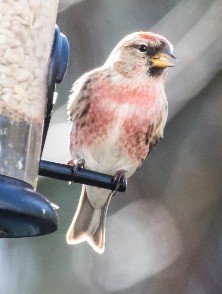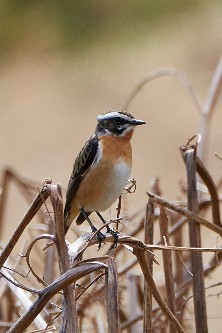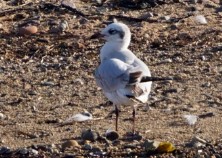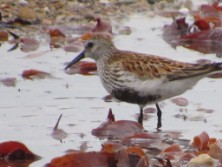April 2022
Bird Sightings



April is the month when spring migration gets underway, with arrivals and departures of birds, all seeking their best breeding territories. April was warmer and dryer than March. In comparison to last April, it was warmer. Last April was exceptionally dry. This April was dry with fifteen days with no measurable rain and one third of the monthly rainfall falling in the last 24 hours. The impact on migrating birds of the weather here and throughout their route is difficult to know, but even by the end of the month the bulk of the migrants had still to arrive.
By the end of March, the first Wheatear, Chiffchaff, Willow Warbler and Sand Martin had been reported. Here are April “firsts” with the 2021 arrival date in brackets for comparison: Swallow 6th(2nd), House Martin 6th(5th), Sandwich Tern 10th(2nd), White Wagtail 13th(17 March), Common Sandpiper 14th(2nd), Sedge Warbler 16th(23rd), Grasshopper Warbler 17th(19th), Cuckoo 17th(14th), Whitethroat 19th(22nd), Tree Pipit 24th(22nd) and Whinchat 24th(21st).
In April some of our wintering birds were still around, including one hundred and two Pink-footed Geese at Sliddery on 1st, ten Wigeon at Cosyden on 2nd, eighty Greylag Geese in Shiskine Valley on 2nd, a Purple Sandpiper at Blackwaterfoot on 7th, a Snow Bunting on Goatfell on 9th, forty Teal at Kilpatrick Point on 11th, a Merlin at Porta Buidhe also on 11th, fourteen Whooper Swan at Cordon on 16th and Brambling records continued to be reported until 17th. It has been an exceptional year for records for this species.
April is an ideal time for watching migration. These are a few examples: ten Linnet and five Twite on Sliddery Shore on 2nd, three Black-throated Diver at Cosyden on 11th, fourteen Meadow Pipit at Auchencar also on 11th, six Golden Plover and twenty-seven Turnstone at Catacol Bay on 23rd, eight Great Northern Diver in Machrie Bay on 25th and two Dunlin at Porta Buidhe on 28th. In addition, groups of migrating Whimbrel were feeding on Kildonan beaches with eleven in Auchenhew Bay on 28th. One of these Whimbrel, A2, had been ringed on a southern Arran shore in 2017. It was reported for the fifth year in a row, having again spent the winter in Africa! It featured in a recent “Banner” article.
Migration was also in evidence from the widespread reports received of Goldfinch and Siskin moving through people's gardens throughout the month. Larger garden numbers reported included thirty Goldfinch at Pirnmill on 7th and thirty Siskin at Strathwillan on 28th. In addition, there were widespread reports of Lesser Redpoll at garden feeders including twenty in Strabane on 17th. Tens of thousands of birds seem to be moving through the island at this time of year.
In April there were over one hundred and ten species recorded on Arran. One of these, a Little Egret , seems to have over-wintered on Arran and as the breeding season approached it seems to have again left. This winter it was first reported on 29 October in Cordon and the last report received was at Clauchlands on 9 April. Here is a further small selection from this list: six Red-throated Dive off Dhunan on 19th, an Osprey carrying a fish by Gortonallister on 25th, a first winter Mediterranean Gull by Fisherman’s Walk on 26th and several reports of Ring Ouzel on the northern mountain ranges at the end of the month.
From a birding point of view, May should be an equally interesting month with the arrival of more summer visitors including Manx Shearwater, Garden Warbler, Lesser Whitethroat, Wood Warbler, Spotted Flycatcher, Swift, Arctic Tern and hopefully, even Corncrake and Nightjar.
Finally, spring is a great time to be birding, as most birds are getting on with the business of breeding. The business of breeding involves attracting a mate by song, courtship display and ritual, defining a territory, nest building, and generally establishing relationships. Please take a moment to report any signs of breeding birds to me. Already there have been reports of Blue Tits nest building, Robins feeding young, Blackbirds carrying food, Fulmars on cliffs and in a small number of areas Lapwing displaying.


